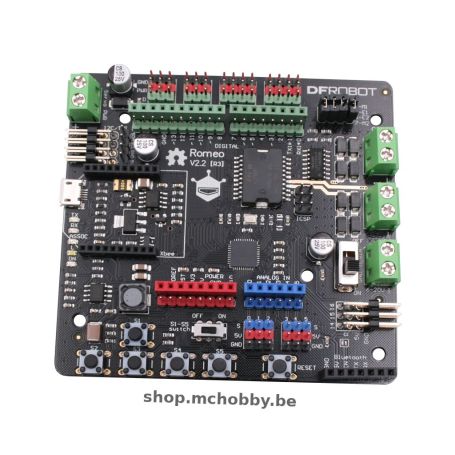Romeo v2 - Arduino compatible + robotic controler
Robotic + microcontroler board
- 32u4 - Arduino Leonardo compatible
- Motor: 6-23V DC
- 2x DC Motor (2A) or 1 Stepper
- XBee connector
- APC220 connector
- microUSB connector
- Also known Romeo V2 / DFR0225
Payments are secured by LyraCollect, a French payment collection company.
It is possible to delivered to your home, to a pick-up point or picked up by appointment at MCHobby
We prepare, pack and ship your orders with great respect and care.
Control your robot with a Ready to Use Microcontroller board + Motor Driver board
This product is known as the Romeo V2.
Romeo V2 is a Robot Control Board properled by an 32U4 (Arduino Leonardo) together with an Motor Driver to drive 2 DC motors (6-23V DC, 2Amp).
This board is designed for robotics applications and extended devices. Romeo is an Arduino Leonardo compatible MCU and can easily be programmed with Arduino IDE. It can benefits from the thousands of open source projects already existing for sensors. The board can also be extended with Arduino shield as it also fits an Arduino R3 compatible Shields connector. The motors are carried by a well known L298 driving 2 way DC motor driver (or one single DC Stepper motor).
The board also fist connector (Xbee socket & APC220) to make your project wireless.
As the Romeo V2 behaves like Arduino Leonardo thanks to it ATmega32u4 chip, You can program it directly from the Arduino IDE. The microcontroler drives all the feature of the board, so it is easy to understand the Romeo beahvior and have a precise control from your Arduino code. The 32U4 do have native USB support, so the Leonardo code libraries can also be used to emulate a computer keyboard, mouse, and more using the very interesting USB-HID protocol!
The great advantage of the ATmega32u4 is the two serial ports allowing to upload your code and seen debugging messages via USB while keeping uploading sketches without removing wireless modules. Debugging is no longer a painful task.
More information on the manufacturer product page.
Technical details
- Microcontroller: ATmega32u4 (Arduino Leonardo Bootloader)
- Offers Arduino R3 connector + pin mapping
- DC Supply: Auto-select USB Powered or External 6V ~ 23V DC
- Board DC Output: 2 Amps @ 5V/3.3V DC
- Motor Driver: L298
- Motor Continuous Current: 2A
- Two-way Motor Driver with 2A maximum current
- One Stepper Motor Drive with 2A maximum current
- Analog Inputs: A0-A5, A6 - A11 (on digital pins 4, 6, 8, 9, 10, and 12)
- PWM: 3, 5, 6, 9, 10, 11, and 13. Provide 8-bit PWM output
- Serial Interface: TTL Level, USB
- Three I2C Interface Pin Sets (two 90°pin headers)
- 5 key inputs for testing (connectable to A0)
- Built-in socket connector for Xbee (not included)
- Build-in sokect connector for APC220 RF Module (not included) and DF-Bluetooth Module (not included)
- Support Male and Female Pin Header
- Size: 89 x 84 x 14mm
- Romeo board schematic (pdf)
Tutorials
- Romeo V2 wiki (DFRobot, English)
- Stepper Motor Library for Romeo (DFRobot, zip)
- Tip to change sensor cable Pin mapping (DFRobot, blog)















